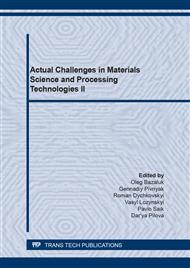[1]
Kumar, G.S., Balamurugan, A., Vinu, S., Radhakrishnan, M., & Senthilprabhu, G. (2012). Tribological and emission studies on two stroke petrol engine lubricated with sunflower methyl ester. Journal of Scientific and Industrial Research, 71, 562-565.
Google Scholar
[2]
Samarth, N.B., & Mahanwar, P.A. (2015). Modified vegetable oil based additives as a future polymeric material – Review. Open Journal of Organic Polymer Materials, 5, 1-22. https://doi.org/10.4236/ojopm.2015.51001.
DOI: 10.4236/ojopm.2015.51001
Google Scholar
[3]
Karmakar, G., & Ghosh, P. (2013). Green Additives for Lubricating Oil. ACS Sustainable Chemistry & Engineering, 1(11), 1364–1370. https://doi.org/10.1021/sc400181g.
DOI: 10.1021/sc400181g
Google Scholar
[4]
Balamurugan, K., Knangasabapathy, N., & Mayilsamy, K. (2010). Studies on Soyabean oil based lubricant for diesel engine. Journal of Scientific and Industrial Research, 69, 794-797.
Google Scholar
[5]
Ghosh, P., Hoque, M., & Karmakar, G. (2018). Castor oil as potential multifunctional additive in the formulation of eco-friendly lubricant. Polymer Bulletin, 75, 501-514. https://doi.org/10.1007/s00289-017-2047-6.
DOI: 10.1007/s00289-017-2047-6
Google Scholar
[6]
Chinchkar, D.S., Satpute, S.T., & Kumbhar, N.R. (2012). Castor oil as green lubricant: A Review. International Journal of Engineering Research and Technology, 1, 1-3.
Google Scholar
[7]
Singh, R.K., Kukrety, A., Kumar, A., Chouhan, A., Saxena, R.C., Ray, S.S., & Jain, S.L. (2017). Synthesis, characterization, and performance evaluation of N,N-Dimethylacrylamide-alkyl acrylate copolymers as novel multifunctional additives for lube oil. Advances in Polymer Technology, 37(6), 1695-1702. https://doi.org/10.1002/adv.21826.
DOI: 10.1002/adv.21826
Google Scholar
[8]
Martini, A., Ramasamy, U.S., & Len, M. (2018). Review of Viscosity Modifier Lubricant Additives. Tribology Letters, 66(2). https://doi.org/10.1007/s11249-018-1007-0.
DOI: 10.1007/s11249-018-1007-0
Google Scholar
[9]
Upadhyay, M., Dey, K., & Ghosh, P. (2016). Biodegradable multifunctional additives for lube oil: Synthesis and characterization. Petroleum Science and Technology, 34(14), 1255-1262. https://doi.org/10.1080/10916466.2016.1190755.
DOI: 10.1080/10916466.2016.1190755
Google Scholar
[10]
Maleque, M.A., Masjuki, H.H., & Sapuan, S.M. (2003). Vegetable‐based biodegradable lubricating oil additives. Industrial Lubrication and Tribology, 55(3), 137-143. https://doi.org/10.1108/00368790310470976.
DOI: 10.1108/00368790310470976
Google Scholar
[11]
Ghosh, P., Hoque, M., & Karmakar, G. (2016). Terpolymers based on sunflower oil/alkyl acrylate/styrene as sustainable lubricant additive. Polymer Bulletin, 74(7), 2685-2700. https://doi.org/10.1007/s00289-016-1863-4.
DOI: 10.1007/s00289-016-1863-4
Google Scholar
[12]
Campanella, A., Rustoy, E., Baldessari, A., & Baltanás, M.A. (2010). Lubricants from chemically modified vegetable oils. Bioresource Technology, 101(1), 245-254. https://doi.org/10.1016/j.biortech.2009.08.035.
DOI: 10.1016/j.biortech.2009.08.035
Google Scholar
[13]
Li, W., Jiang, C., Chao, M., & Wang, X. (2014). Natural Garlic Oil as a High-Performance, Environmentally Friendly, Extreme Pressure Additive in Lubricating Oils. ACS Sustainable Chemistry & Engineering, 2(4), 798-803. https://doi.org/10.1021/sc400462n.
DOI: 10.1021/sc400462n
Google Scholar
[14]
Talukdar, S., & Ghosh, P. (2019). Biodegradable vegetable oil polymer as a multifunctional lubricating oil additive. Journal of Macromolecular Science, Part A, 57(4), 244-249. https://doi.org/10.1080/10601325.2019.1691449.
DOI: 10.1080/10601325.2019.1691449
Google Scholar
[15]
Mohammed, A.H. (2019). Studying Reactivity Relationships of Copolymers N-naphthylacrylamide with (Acrylicacid and Methylacrylate). Baghdad Science Journal, 16(2), 0345. https://doi.org/10.21123/bsj.16.2.0345.
DOI: 10.21123/bsj.2019.16.2.0345
Google Scholar
[16]
Geethanjali, G., Padmaja, K.V., & Prasad, R.B.N. (2016). Synthesis, Characterization, and Evaluation of Castor Oil-Based Acylated Derivatives as Potential Lubricant Base Stocks. Industrial & Engineering Chemistry Research, 55(34), 9109-9117. https://doi.org/10.1021/acs.iecr.6b01550.
DOI: 10.1021/acs.iecr.6b01550
Google Scholar
[17]
Mohammed, A.H., Ahmad, M.B., Ibrahim, N.A., & Zainuddin, N. (2018). Effect of crosslinking concentration on properties of 3-(trimethoxysilyl) propyl methacrylate/N-vinyl pyrrolidone gels. Chemistry Central Journal, 12(1). https://doi.org/10.1186/s13065-018-0379-4.
DOI: 10.1186/s13065-018-0379-4
Google Scholar
[18]
Vynnykov, Yu., Manhura, A., Zimin, O., & Маtviienko, А. (2019). Use of thermal and magnetic devices for prevention of asphaltene, resin, and wax deposits on oil equipment surfaces. Mining of Mineral Deposits, 13(2), 34-40. https://doi.org/10.33271/mining13.02.034.
DOI: 10.33271/mining13.02.034
Google Scholar
[19]
Covitch, M.J., & Trickett, K.J. (2015). How Polymers Behave as Viscosity Index Improvers in Lubricating Oils. Advances in Chemical Engineering and Science, 5(02), 134-151. https://doi.org/10.4236/aces.2015.52015.
DOI: 10.4236/aces.2015.52015
Google Scholar
[20]
Nassar, A.M. (2008). The Behavior of Polymers as Viscosity Index Improvers. Petroleum Science and Technology, 26(5), 514-522. https://doi.org/10.1080/10916460600806101.
DOI: 10.1080/10916460600806101
Google Scholar
[21]
Du, T., Wang, S., Liu, H., Song, C., & Nie, Y. (2012). The Synthesis and Characterization of Methacrylic Acid Ester-maleic Anhydride Copolymer as a Lube Oil Pour Point Depressant. Petroleum Science and Technology, 30(2), 212-221. https://doi.org/10.1080/10916461003662984.
DOI: 10.1080/10916461003662984
Google Scholar
[22]
Jung, K.-M., Chun, B.-H., Park, S.H., Lee, C.H., & Kim, S.H. (2010). Synthesis of methacrylate copolymers and their effects as pour point depressants for lubricant oil. Journal of Applied Polymer Science, 120(5), 2579-2586. https://doi.org/10.1002/app.33330.
DOI: 10.1002/app.33330
Google Scholar


